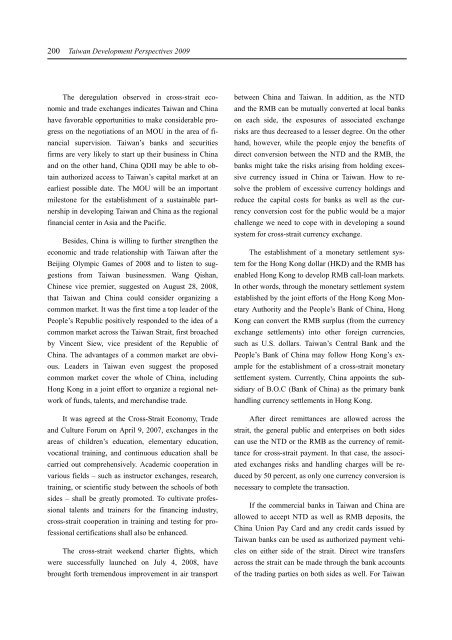PDF(2.7mb) - 國家政策研究基金會
PDF(2.7mb) - 國家政策研究基金會
PDF(2.7mb) - 國家政策研究基金會
Create successful ePaper yourself
Turn your PDF publications into a flip-book with our unique Google optimized e-Paper software.
200 Taiwan Development Perspectives 2009<br />
The deregulation observed in cross-strait economic<br />
and trade exchanges indicates Taiwan and China<br />
have favorable opportunities to make considerable progress<br />
on the negotiations of an MOU in the area of financial<br />
supervision. Taiwan’s banks and securities<br />
firms are very likely to start up their business in China<br />
and on the other hand, China QDII may be able to obtain<br />
authorized access to Taiwan’s capital market at an<br />
earliest possible date. The MOU will be an important<br />
milestone for the establishment of a sustainable partnership<br />
in developing Taiwan and China as the regional<br />
financial center in Asia and the Pacific.<br />
Besides, China is willing to further strengthen the<br />
economic and trade relationship with Taiwan after the<br />
Beijing Olympic Games of 2008 and to listen to suggestions<br />
from Taiwan businessmen. Wang Qishan,<br />
Chinese vice premier, suggested on August 28, 2008,<br />
that Taiwan and China could consider organizing a<br />
common market. It was the first time a top leader of the<br />
People’s Republic positively responded to the idea of a<br />
common market across the Taiwan Strait, first broached<br />
by Vincent Siew, vice president of the Republic of<br />
China. The advantages of a common market are obvious.<br />
Leaders in Taiwan even suggest the proposed<br />
common market cover the whole of China, including<br />
Hong Kong in a joint effort to organize a regional network<br />
of funds, talents, and merchandise trade.<br />
It was agreed at the Cross-Strait Economy, Trade<br />
and Culture Forum on April 9, 2007, exchanges in the<br />
areas of children’s education, elementary education,<br />
vocational training, and continuous education shall be<br />
carried out comprehensively. Academic cooperation in<br />
various fields – such as instructor exchanges, research,<br />
training, or scientific study between the schools of both<br />
sides – shall be greatly promoted. To cultivate professional<br />
talents and trainers for the financing industry,<br />
cross-strait cooperation in training and testing for professional<br />
certifications shall also be enhanced.<br />
The cross-strait weekend charter flights, which<br />
were successfully launched on July 4, 2008, have<br />
brought forth tremendous improvement in air transport<br />
between China and Taiwan. In addition, as the NTD<br />
and the RMB can be mutually converted at local banks<br />
on each side, the exposures of associated exchange<br />
risks are thus decreased to a lesser degree. On the other<br />
hand, however, while the people enjoy the benefits of<br />
direct conversion between the NTD and the RMB, the<br />
banks might take the risks arising from holding excessive<br />
currency issued in China or Taiwan. How to resolve<br />
the problem of excessive currency holdings and<br />
reduce the capital costs for banks as well as the currency<br />
conversion cost for the public would be a major<br />
challenge we need to cope with in developing a sound<br />
system for cross-strait currency exchange.<br />
The establishment of a monetary settlement system<br />
for the Hong Kong dollar (HKD) and the RMB has<br />
enabled Hong Kong to develop RMB call-loan markets.<br />
In other words, through the monetary settlement system<br />
established by the joint efforts of the Hong Kong Monetary<br />
Authority and the People’s Bank of China, Hong<br />
Kong can convert the RMB surplus (from the currency<br />
exchange settlements) into other foreign currencies,<br />
such as U.S. dollars. Taiwan’s Central Bank and the<br />
People’s Bank of China may follow Hong Kong’s example<br />
for the establishment of a cross-strait monetary<br />
settlement system. Currently, China appoints the subsidiary<br />
of B.O.C (Bank of China) as the primary bank<br />
handling currency settlements in Hong Kong.<br />
After direct remittances are allowed across the<br />
strait, the general public and enterprises on both sides<br />
can use the NTD or the RMB as the currency of remittance<br />
for cross-strait payment. In that case, the associated<br />
exchanges risks and handling charges will be reduced<br />
by 50 percent, as only one currency conversion is<br />
necessary to complete the transaction.<br />
If the commercial banks in Taiwan and China are<br />
allowed to accept NTD as well as RMB deposits, the<br />
China Union Pay Card and any credit cards issued by<br />
Taiwan banks can be used as authorized payment vehicles<br />
on either side of the strait. Direct wire transfers<br />
across the strait can be made through the bank accounts<br />
of the trading parties on both sides as well. For Taiwan

















